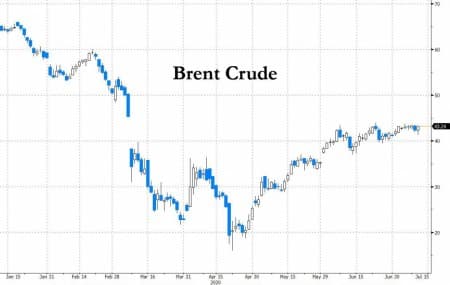In retrospect, it’s impressive that it lasted as long as it did. Four months after OPEC cobbled together a record production cut to offset the demand destruction unleashed by the COVID-19 lockdowns, R-OPEC+ (i.e., OPEC plus Russia and a bunch of non-OPEC exporters) is set to slowly resume pumping more after an alliance of producers led by Saudi Arabia wants to increase oil production starting in August, amid signs that demand is returning to normal levels following coronavirus-related lockdowns Bloomberg and the Journal reported overnight.
Bloomberg confirms as much, noting overnight that “having successfully doubled crude prices over the past few months through unprecedented output cuts, the OPEC+ alliance led by the Saudis and Russia is poised to begin unwinding these stimulus measures. As fuel demand recovers with the lifting of coronavirus lockdowns, the producers are about to open the taps a little.”
According to the report, alliance members will meet via zoom on Wednesday to debate the group’s current and future production, which include plans to restore some 2 million in production following the record production cut in April which saw Saudi Arabia push for a 9.7 million b/d in production stoppages as the pandemic led to a collapse of oil demand. More from BBG:
The JMMC will consider whether the 23-nation alliance should keep 9.6 million barrels of daily output off the market for another month, or restore some supplies as originally planned, tapering the cutback to 7.7 million barrels.
As the demand recovery gains traction, members are leaning toward the latter option, according to several national delegates who asked not to be identified. Shipping schedules for August are already being set, so the course is more or less locked in, one said.
While all this sounds great in principle, in practice it will likely send the price of oil crashing because just as there was a massive uphill battle in April to get everyone on the same page (and even that did not stop oil from hitting a record negative price on April 20), so now that production quotas are being eased, the result will be a furious scramble to outproduce everyone else, as OPEC’s most characteristic feature is exposed for the entire world to see: cheating.
“If OPEC clings to restraining production to keep up prices, I think it’s suicidal,” a person familiar with the Saudis’ thinking told the Journal. “There’s going to be a scramble for market share, and the trick is how the low-cost producers assert themselves without crashing the oil price.”
“When they look at prices over the quarter, when they look at green shoots of demand pick-up, I think they feel good,” RBC commodity strategist Helima Croft told Bloomberg. “I do think they are cognizant though of some of the potential clouds on the horizon.”
Still, with OPEC+ oil exports generating far less state revenues than pre-COVID, the oil producers have little choice but to agree to pump more even if it means sharply lower prices (and yet another round of production cuts in a few weeks). Indeed, producers’ relative optimism coincides with a Friday report from the International Energy Agency showing the worst effects of the coronavirus on global oil demand have passed, although as we showed on Friday, it now appears that record numbers of cases are once again starting to impact mobility and travel.
Indeed, as Bloomberg admits, a second wave of the pandemic threatens another slump in oil consumption, while the billion-barrel mountain of inventories that piled up during the first outbreak still looms. If OPEC+ increases supply just as the market falters then prices could crash once again.
Despite draconian production cuts, Brent remains down 31% since the beginning of the year, at $43.24 a barrel, while West Texas Intermediate futures, the benchmark in U.S. oil markets, have traded at around $40 a barrel since late June after falling below zero at one point in April.

As a reminder, back in late Q1, the market was generally ignoring news of the COVID pandemic until the March 6th failure between Saudi Arabia and Russia to agree on a production cut quote (a mistake which was promptly remedied a month later), at which point stocks imploded and the S&P saw a record number of limit down overnight future sessions.
Is OPEC+ about to unleash another round of market chaos?




















